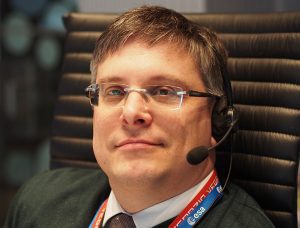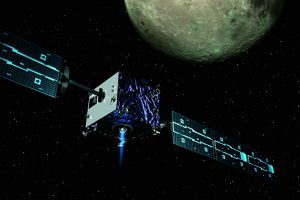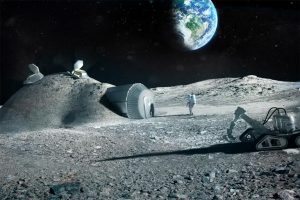After fifty years, mankind is going back to the Moon, and this time for a longer stay. Exploring the Moon further is another step towards human development on Earth and a steppingstone for future missions to Mars. Ultimately, aiming for the Universe.
“One small step for man, one giant leap for mankind.”Those are the famous words, uttered by the American astronaut Neil Armstrong as he set foot on the Moon on 20 July, 1969. A historical event that, at the time, was considered the greatest accomplishment in the on-going Space Race between the United States and the Soviet Union. National pride drove the competition to be the most technologically superior nation. Visiting the Moon was the ultimate prize, the crown jewel in the contest. Not because it was important to walk on the Moon. Sam Peterson, Director of Strategy & Innovation at SSC, sums up another reason in one sentence (and smiles): “We went to the Moon because it’s there”.
Of course, it´s our closest neighbor, but there was also some curiosity in what we would find there. Water? Life? Rare elements? Let´s put it like this: Mankind quickly lost interest in this cold satellite and has not revisited for a long time. The Apollo 17 mission in December 1972 is the most recent time that humans set foot on the Moon.
Exciting lunar missions in preparation

Much has changed over the years. And now when mankind is yet again making itself ready to go back to the Moon, SSC will be an integral part of those journeys, as a service provider enabling some of the most exciting lunar missions in preparation. Utilizing one of the world’s largest and most advanced global ground station networks, including historic sites from the early days of lunar exploration, SSC has delivered communication’s technology, mission preparation and payload design for longer than most other companies.
“We have a heritage back to the first Apollo mission where our Santiago ground station was part of NASA’s tracking station network. But SSC´s first real mission was the Swedish designed SMART-1 in 2003, a sun cell powered satellite that orbited the Moon before (deliberately) impacting its surface,” says Sam Peterson.
Since then, SSC has been involved in several missions, for example providing lunar services to NASA’s Lunar Reconnaissance Orbiter since 2009 (mapping the Moon’s surface) and to SpaceIL’s Beresheet mission, the first privately funded spacecraft to reach the moon in 2019.
Permanent base camps on the Moon

As of today, SSC provides routine support for two satellites orbiting the Moon. The company is also a contracted partner to coming high-profile lunar missions for new space players such as Firefly’s Blue Ghost mission, Astrobotic’s Griffin Mission One mission and Masten’s XL-1 Mission.
Right now, most eyes are on Artemis, NASA’s ambitious program that aims to put humanity back on the Moon and build permanent base camps there. And yes, SSC will support the Artemis mission too.
“We can use the Moon as a springboard to Mars and the rest of the solar system.”
“Before this decade is over, astronauts will stay on the Moon for a longer time. This is crucial for future space exploration, as we then can use the Moon as a springboard to Mars and the rest of the solar system and even beyond,” says Sam Peterson, and continues:
“But before going to Mars we need to create a habitat on the Moon. This is a great challenge, for instance, a lunar day is fourteen days on Earth. After that, fourteen nights follow, with no sun to produce energy. Also, we need to learn how to produce water and food, how to extract materials and manufacture things away from Earth.”
Building a lunar gateway
These are just a few of the issues that need to be solved before the first permanent base camp on the Moon can be put in use. Space exploration used to be a thing for governments only. But today, the barrier is so much lower, and the commercial sector has become a big part of the industry. Small companies with big ideas can lead the way in the future. Reduced launch costs and smaller payloads are helping us do things we could not do before.
So, what is to be expected in the next few years? A lot more commercial missions, rovers landing on the Moon, payloads gathering information, satellites in lunar orbit, further exploring of exploring of the surface. All this leading up to building a lunar gateway for future exploration of the solar system.

“Using the Moon as a permanent base for further exploration of Space is much more sustainable. It will require less energy and fewer materials from Earth to launch unmanned missions to different parts of the solar system,” says Sam Peterson.
Maybe twenty years from going to Mars
The dream of terraforming the Moon is getting closer and closer to coming true, and even permanent bases on Mars are no longer a science-fiction fantasy.
“For my entire life, we have always been twenty years away from going to Mars. It’s been a moving target. But I think we could achieve this in twenty years if there was just enough will. Maybe Musk will change it,” says Sam Peterson.
He has his own dreams beyond the solar system: A probe that reaches our closest star, the Proxima Centauri, only four light years away.
“If we could reach a tenth of the speed of light, a spacecraft could get there in forty years. And sending back data would take four years. That would be something to experience, a dream come true for sure.”
A tool for humankind to become multiplanetary? A way to find the answers for saving what we have here on Earth? Or just a means for us to still our thirst for exploration? Perhaps a combination of it all. One thing is for sure, we’re going back to the Moon and SSC is part of the journey.

